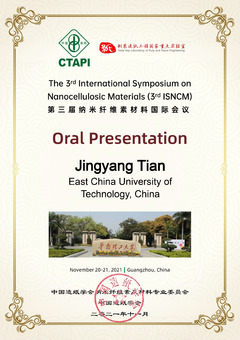Synthesis of nitrogen and sulfur codoped multilevel porous carbon from lignin for high-performance supercapacitors
ID:78
View Protection:PRIVATE
Updated Time:2021-11-15 15:25:05
Hits:1062
Oral Presentation
Abstract
Supercapacitors have attracted considerable attention due to their superior electrochemical performance, such as higher power density, faster charge and discharge, and longer cycle life than the conventional dielectric capacitor. In response to the ever-increasing depletion of fossil fuels and global warming, the supercapacitors are used in a wider range, particularly in electric vehicles and portable power tools. Based on the energy storage mechanism, electrochemical capacitors can be categorized into two types: electrical double-layer capacitors (EDLCs) and pseudocapacitors. The energy storage of EDLCs is ascribed to the accumulation and release of electrostatic charge in the Helmholtz double layer formed at the electrode and electrolyte interface. Therefore, the specific surface area and pore size distribution, especially, are the critical factors which can influence the electrochemical performance of EDLCs.
Generally, porous active carbon (AC) is used as the electrode materials for EDLCs due to the high specific surface area and abundant micropores (0.3 nm) and mesopores with random pore connection. Heteroatoms doping into the AC have attracted more attention for the definite enhancement of electrochemical performance. Lots of theoretical calculation and experimental results have demonstrated that the introduction of heteroatoms, such as N, P, S, and B can effectively improve the electrochemical activity. Among these heteroatoms, nitrogen or sulfur has been widely investigated due to the tuning electrochemistry of carbon atom. However, the doping of single heteroatoms into porous carbon shows limited improvement in the energy storage, especially for the sulfur atoms. Besides, the doping of sulfur usually used the toxic precursors, such as benzyl disulfide, hydrogen sulfide and carbon disulfide. In order to further improve the porous carbon performance by synergistic effects, codoping with two heteroatoms, such as nitrogen and sulfur is a promising strategy for the supercapacitor application.
The lignin by-products are converted into the three-dimensional interconnected nitrogen and sulfur codoped porous carbon materials by the carbonization and KOH activation process. The as-obtained N,S-HPC-1 shows the multilevel pore structure (macro-, meso-, and micropores) with a high specific surface area of 1454.7 m2 g−1, high nitrogen and sulfur content up to 2.1 and 4.3 wt%. As a result, the N,S-HPC-1-based supercapacitor shows a high specific capacitance of 271 F g−1 at 0.5 A g-1, excellent rate performance of 62% capacitance retention at 50 A g-1, and favorable capacitance retention of 98.4% after 10,000 cycles at 5 A g−1. Furthermore, it can yield a remarkable energy density of 37.6 Wh kg-1 at a power density of 62 W kg-1. These results exhibit a low-cost and environmental strategy of the lignin utilization for electrodes of supercapacitors.
Keywords
Supercapacitor; electrical double-layer capacitors; mesopores; codoping



Comment submit